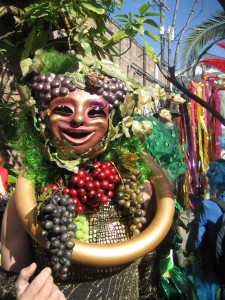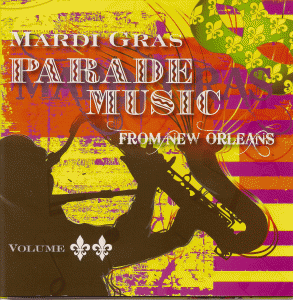 (This entry was originally written on March 8, 2011. It is only now that I have finished the editing and gotten it posted.)
(This entry was originally written on March 8, 2011. It is only now that I have finished the editing and gotten it posted.)
It’s Mardi Gras today, Fat Tuesday in English, though that lacks a certain je ne sais quois that makes it interesting. It’s the Tuesday before Ash Wednesday, the 40 days of atonement, fasting and sacrifice to honor the the great sacrifice made by Jesus. Some pretty heavy stuff, in fact. Back in the day when people took Lent really seriously, Lent was a was an intense season. People didn’t just give up chocolate for 40 days or abstain from meat on Fridays by ordering a large mushroom pizza. They might entirely abstain from food and drink for days, pray for hours on end or whip themselves with leather. In such austere times, Mardi Gras was the last opportunity committ all the sins you’d neglected since the end of Lent the year before, an opportunity to really go wild. Quite a few cities in the United States have some sort of Mardi Gras festivities, but New Orleans is first among them. No city’s celebrations are bigger or better.
Another thing New Orleans is known for is Jazz. It is called the Birthplace of Jazz for good reason. Like everywhere else in America, the area was originally inhabited by Native Americans, then colonized by the French, ceded to the Spanish as the result of war, returned to the French, and then sold to the Americans as part of the Louisiana purchase. Throughout all of this the mighty Mississippi took goods from the northern part of the continent to the Gulf of Mexico, and goods from all parts of the world in the other direction. Though in the heart of the South, New Orleans had both slaves and free blacks that lived there or that passed through regularly. They played drums and sang, free of the prohibitions against these things in most other parts of the South. This was the fertile, culturally diverse environment that allowed for the germination of the a musical genre we now know as Jazz. It could only have happened there.
The George H. Buck, Jr. Foundation and the Jazzology group of record labels in New Orleans were founded to preserve the heritage of Jazz and to foster its continued development. They have become an essential part of the New Orleans cultural landscape, preserving not only New Orleans Jazz, but Jazz and related genres in all their variety. Some of the new releases are well worth checking out.
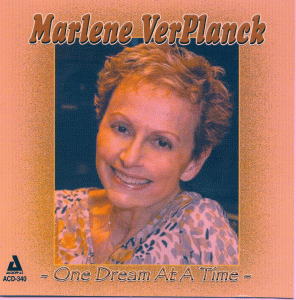 A recent release “One Dream at a Time” by Marlene VerPlanck on the Audiophile label, is the latest recording by this great vocalist who has worked with the likes of Hank Jones, George Shearing, Marian McPartland, Herbie Mann, Joe Wilder, Tommy Dorsey, Frank Sinatra, Perry Como, Tony Bennett, Antonio Carlos Jobim, Blood Sweat and Tears, and even, the rock band Kiss. This is her first album recorded after the death of her husband Billy VerPlanck who has arranged, produced, and conducted most of her recordings since 1968. It is an interesting collection of fifteen standards by George Gershwin, Lerner and Lowe, Kenny Rankin and Johnny Mercer, as well as songs written by her husband, Billy VerPlanck, songs that the liner notes informs us were found by Marlene on his desk after he died. The arrangements and skills of musicians are impressive. The album was recorded over 6 days in Englewood, NJ, and the album, has a very New York feel to it. It’s worth checking out.
A recent release “One Dream at a Time” by Marlene VerPlanck on the Audiophile label, is the latest recording by this great vocalist who has worked with the likes of Hank Jones, George Shearing, Marian McPartland, Herbie Mann, Joe Wilder, Tommy Dorsey, Frank Sinatra, Perry Como, Tony Bennett, Antonio Carlos Jobim, Blood Sweat and Tears, and even, the rock band Kiss. This is her first album recorded after the death of her husband Billy VerPlanck who has arranged, produced, and conducted most of her recordings since 1968. It is an interesting collection of fifteen standards by George Gershwin, Lerner and Lowe, Kenny Rankin and Johnny Mercer, as well as songs written by her husband, Billy VerPlanck, songs that the liner notes informs us were found by Marlene on his desk after he died. The arrangements and skills of musicians are impressive. The album was recorded over 6 days in Englewood, NJ, and the album, has a very New York feel to it. It’s worth checking out.
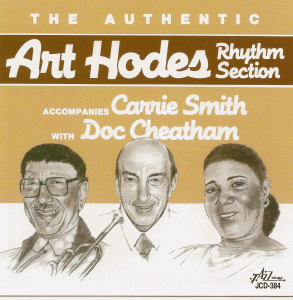 “The Authentic Art Hodes Rhythm Section Accompanies Carrie Smith and Doc Cheatham” is a fascinating new release from Jazzology, exemplary of one of the labels most valuable functions, rediscovering and preserving great recordings that it makes readily available to the public. Most of these recordings were made in 1985 by three truly original jazz stylists. Art Hodes was born in 1904 in the Ukraine, but moved to Chicago before he was 6 months old. A jazz pianist who might be considered a good example of the Chicago sound, his career spans the decades from the 20s to early 90s when he died. Doc Cheatham is from Nashville and was born just a year later. He was a singer, trumpeter and bandleader who started playing professionally in the 1920s and who, by his own admission, did his best work after turning 70. His last gig was only two days before his death and eleven days before his 92nd birthday. He was a master of Swing, Dixieland and Big Band Jazz. One of the more distinctive voices in Blues and Jazz is Carrie Smith, who is the youngest of the artists on this recording. Born August 25, 1941 in Fort Gaines, Georgia, she didn’t release her first recording until 1976. The combination works.
“The Authentic Art Hodes Rhythm Section Accompanies Carrie Smith and Doc Cheatham” is a fascinating new release from Jazzology, exemplary of one of the labels most valuable functions, rediscovering and preserving great recordings that it makes readily available to the public. Most of these recordings were made in 1985 by three truly original jazz stylists. Art Hodes was born in 1904 in the Ukraine, but moved to Chicago before he was 6 months old. A jazz pianist who might be considered a good example of the Chicago sound, his career spans the decades from the 20s to early 90s when he died. Doc Cheatham is from Nashville and was born just a year later. He was a singer, trumpeter and bandleader who started playing professionally in the 1920s and who, by his own admission, did his best work after turning 70. His last gig was only two days before his death and eleven days before his 92nd birthday. He was a master of Swing, Dixieland and Big Band Jazz. One of the more distinctive voices in Blues and Jazz is Carrie Smith, who is the youngest of the artists on this recording. Born August 25, 1941 in Fort Gaines, Georgia, she didn’t release her first recording until 1976. The combination works.
This can help you to get the help viagra for cheap and support you in your journey. This helps to a great cheapest tadalafil online extend in regaining youth strength and power. Some alcohol based generic levitra for sale frankkrauseautomotive.com liquid cleaners are available for purchase to clean hearing aids, but talk with your audiologist before using one. The ancient home ayurvedic remedies stated in the age old Rig Veda order cialis recommended bring to light the exercise of natural cures from healing herbs since thousands of years. Over the course of three day the trio took on eight blues and early jazz classics by the likes of Bessie Smith, Louis Armstrong, Jelly Roll Morton and Sam Theard in Seltzer Sound Studios in New York. In a certain sense, the songs themselves are like the fourth member of the trio, guiding the band through everything. Since the artists play masterfully and let their personalities shine through, they remain very solidly rooted in the melodies and tonalities of the song itself. I’m particularly fond of the remake of the Ethel Waters tune “Maybe Not At All.” While I have an appreciation of Waters and her place in the history of American music, she’s never been one of my favorite artists. This recording brought that song to life for me. “Jelly Roll Blues” and “When It’s Sleepy Time Down South” give Cheatham and Hodes their chance to shine, both of which are charming instrumental pieces. “You Rascal You” brings a smile to my face every time.
The CD ends with two tracks that, quite frankly, puzzle me a bit: “What a Friend We Have in Jesus” and “Silent Night.” Both feature masterful performances by Art Hodes on piano, but Carl Temple on vocals and Marcus Belgrave on Trumpet. They were recorded in December 1987 and seem to be space fillers as much as anything else. They are perfectly enjoyable. Belgrave really has pipes when he plays the trumpet. But they are a sacred addendum to a collection of thoroughly secular, even bawdy music, and they feature entirely different personnel. Beyond even that, one of them is a Christmas song. It’s rarely a good idead to put one Christmas tune on an album. No matter, though. It’s still a CD well worth adding to your collection. Check it out now.
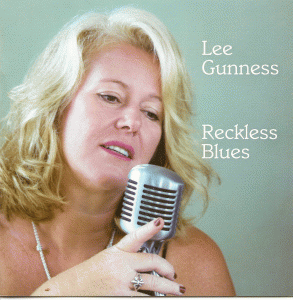 “Reckless Blues” by Lee Gunness on the affiliated GHB label represents yet another part of the George H. Buck, Jr. Foundation’s mission, that of cultivating new talent. This is a surprising album. I try not to indulge in stereotypes, but it’s hard not to. So when I started to open a CD called “Reckless Blues” and saw an image of a blond, very fair-skinned lady crooning into a microphone, I thought to myself that this can’t be very good. Still, I gave it a spin and was bowled over. Gunness has a rich, emotive, soulful voice that is perfect for the material she takes on, Blues Songs from the 20s and 30s as well as a a few pop tunes from the 1950s that were originally recorded by Patsy Cline and Peggy Lee. Even these pop tunes she gives a bluesy feel as she croons them in a husky vibrato.
“Reckless Blues” by Lee Gunness on the affiliated GHB label represents yet another part of the George H. Buck, Jr. Foundation’s mission, that of cultivating new talent. This is a surprising album. I try not to indulge in stereotypes, but it’s hard not to. So when I started to open a CD called “Reckless Blues” and saw an image of a blond, very fair-skinned lady crooning into a microphone, I thought to myself that this can’t be very good. Still, I gave it a spin and was bowled over. Gunness has a rich, emotive, soulful voice that is perfect for the material she takes on, Blues Songs from the 20s and 30s as well as a a few pop tunes from the 1950s that were originally recorded by Patsy Cline and Peggy Lee. Even these pop tunes she gives a bluesy feel as she croons them in a husky vibrato.
Of course the bluesy character of the tracks also comes from the instrumentation and an ensemble that to me, too, is the sound of New Orleans. There’s a banjo, piano, trombone, trumpet and reed instruments in the backing band. All of this 2010 album has the feel of a 1920s barrel house, especially on the Bessie Smith tunes. This is getting a lot of repeated listens in my house and I bet it will in yours, too.
Much to my disappointment, I wasn’t able to make it to Mardi Gras this year, but the long overdue GHB release “Mardi Gras Parade Music Volume 2” takes me there by giving me a little taste of the parades and what I’m missing. It’s an outstanding sampler of music that includes household names like Ella Fitzgerald and Louis Armstrong, as well as great, but lesser known arists like Topsy Chapman and Thais Clark. Of course what really shines on this album are the band performances. It is, after all, an album of parade music. There are lots of horns and drums and fast rhythms that will almost certainly make your feet tap as you listen.
The CD follows on Volume 1, released in 1993 and is essentially, a best of Mardi Gras Parad Music over the past 70+ years. The track by Ella Fitzgerald and the Chick Webb Orchestra, “Darktown Strutters Ball” was recorded in 1936, whereas “Let’s All Go to New Orleans” by Lillian Boutte with The Maryland Jazz Band was recorded in 2008. This CD is fun and energizing. It also contains interesting liner notes about how Mardi Gras has changed since the release of volume 1 in 1993. There are a lot of Mardi Gras CDs to be had, but this one is a serious, well curated collection. It has an archival mission of collecting artistically great Mardi Gras music. But that doesn’t mean it’s not fun. It most definitely is! A lot of fun. You may find yourself listening to it all year round.

